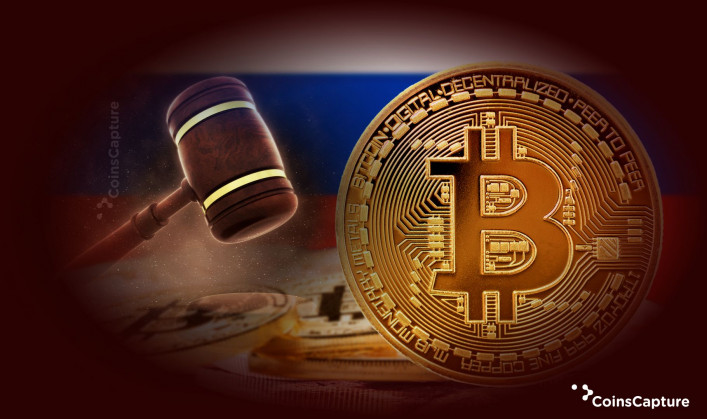7 November 2025
The Russian Cryptocurrency Laws and Regulations
Like in other countries, Russia is seeing a rise in the use of Cryptocurrency. On the path to widespread Cryptocurrency acceptance, meanwhile, it confronts significant challenges. Let's take a deeper dive into the state of the Cryptocurrency market in Russia by analyzing the nation's Cryptocurrency regulations. In a discussion paper titled "Cryptocurrencies: Trends, Risks, and Regulation," the Bank of Russia addressed these issues. The report estimates that annual Cryptocurrency transactions among Russian residents approach $5 billion.
Also Read: Expanded XRP Trading On Australia's Major Exchanges
About Russia’s Cryptocurrency
In regards to overall land area, Russia is the world's largest nation. If you look at a map, you'll see that Russia is situated higher than Kazakhstan, Mongolia, as well as China. In terms of land area, Russia is far larger than China is, but the reverse is not true when it comes to people. Still, Russia is still one of the world's most populated nations. This region is also referred to as Russia or the Russian Federation. Russia's official money is called a ruble. While the nation assesses its regulatory position on many areas of the asset class, the Cryptocurrency industry in Russia is still maturing. It is important to note that Bitcoin and other Crypto assets are not recognized as legal tender in Russia. Some government employees are also barred from owning Cryptocurrencies.
Also Read: Crypto Activity Warned By US Federal Regulators
Features of Cryptocurrencies in Russia
Following are the 4 main features of Cryptocurrencies that Bank of Russia expresses its concerns on:
- The risk of substantial loss for investors due to the extreme turbulence.
- Russia's ability to control rising prices might be hampered by the widespread use of Cryptocurrencies.
- The actual economy may have trouble being funded if Russians withdrew their funds en masse from the banking industry.
- Some bad things are bought and sold using Cryptocurrency.
More on Cryptocurrencies in Russia
A few short months ago, officials in the Kremlin were as uninterested in Cryptocurrency as Siberian snow. Russia's ability to conduct financial transactions internationally was severely hampered after the invasion of Ukraine and subsequent sanctions imposed by a wide range of nations. For whatever reason, what was formerly seen as a terrible idea—an anonymous, low-cost means of transferring payments across international boundaries that simultaneously challenged the dollar's privileged status as the world's reserve currency—began to seem like a good one. As part of its ongoing efforts to modernize its financial system and expand its power in the world's financial system, Russia is now aggressively shifting to Cryptocurrency, preparing to rouble in the first quarter of 2023. The European Union, on the other hand, has other views as well as put further limits on Russia's Crypto activity in September.
Yet, the article covers more than just Cryptocurrency. The stability of stablecoins is also seen as a risk to the Russian market. The Bank of Russia has proposed a number of measures to regulate Cryptos in the nation, including a ban on using Crypto as a payment method, a ban on the issuance and circulation of Cryptocurrency, as well as the establishment of obligations for companies which violate the prohibition on virtual currency issuance as well as transmission. Ivan Chebeskov, an official of the Russian Ministry of Finance, replied to the request made by the Central Bank, continuing the tale. In his opinion, Cryptocurrencies need to be regulated, not outlawed.
As of January 2022, the nation has proposed a comprehensive ban on Cryptocurrency activity, including trading, issuance, as well as mining. In July 2022, President Putin approved a measure that made it illegal to utilize Cryptocurrencies like Bitcoin to buy products as well as facilities inside the country. In an effort to stymie Russia's efforts to preserve its role in international banking, the European Union has decided to bar Russian residents from using EU Crypto wallets to store their wealth. But, that danger might be symbolic rather than actual. Using a non-custodial wallet such as Metamask renders this assertion meaningless, since all users complete the transaction remotely on their own devices regardless of their location. It is impossible for us to determine their precise location. If the item is stored in a custodial wallet, the owner is adhering to KYC procedures.
Statistics on Cryptocurrencies in Russia
There seemed to be friction between the Bank of Russia as well as the Finance Ministry shortly after the release of the discussion document. Unfortunately, they were unable to agree on a plan for the long-term management of Cryptocurrencies. Two bodies abruptly reached an agreement in February on a plan to control the flow of Cryptocurrencies across borders. Bankless Times reports that 10.1% of Russians, or 14.6 million people, already possess Cryptocurrencies. Ethereum (ETH) is the most popular Cryptocurrency, with 32 percent of voters going that route. Bitcoin comes in at second position, with 30.8% of those claiming to own some. Most Russian Cryptocurrency owners are rather young, between the ages of 18 and 34.
Disclaimer: The author’s thoughts and comments are solely for educational reasons and informative purposes only. They do not represent financial, investment, or other advice.






